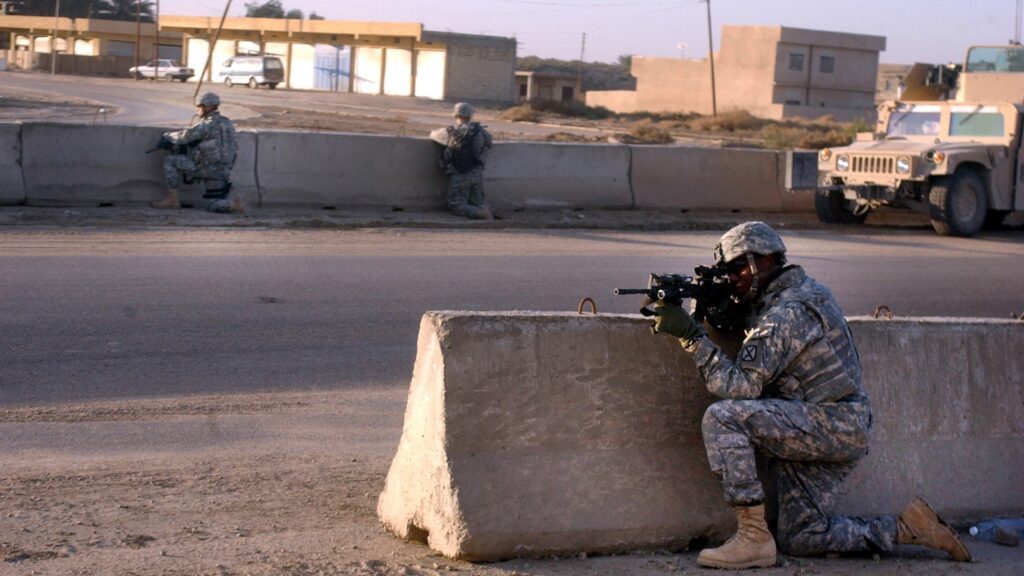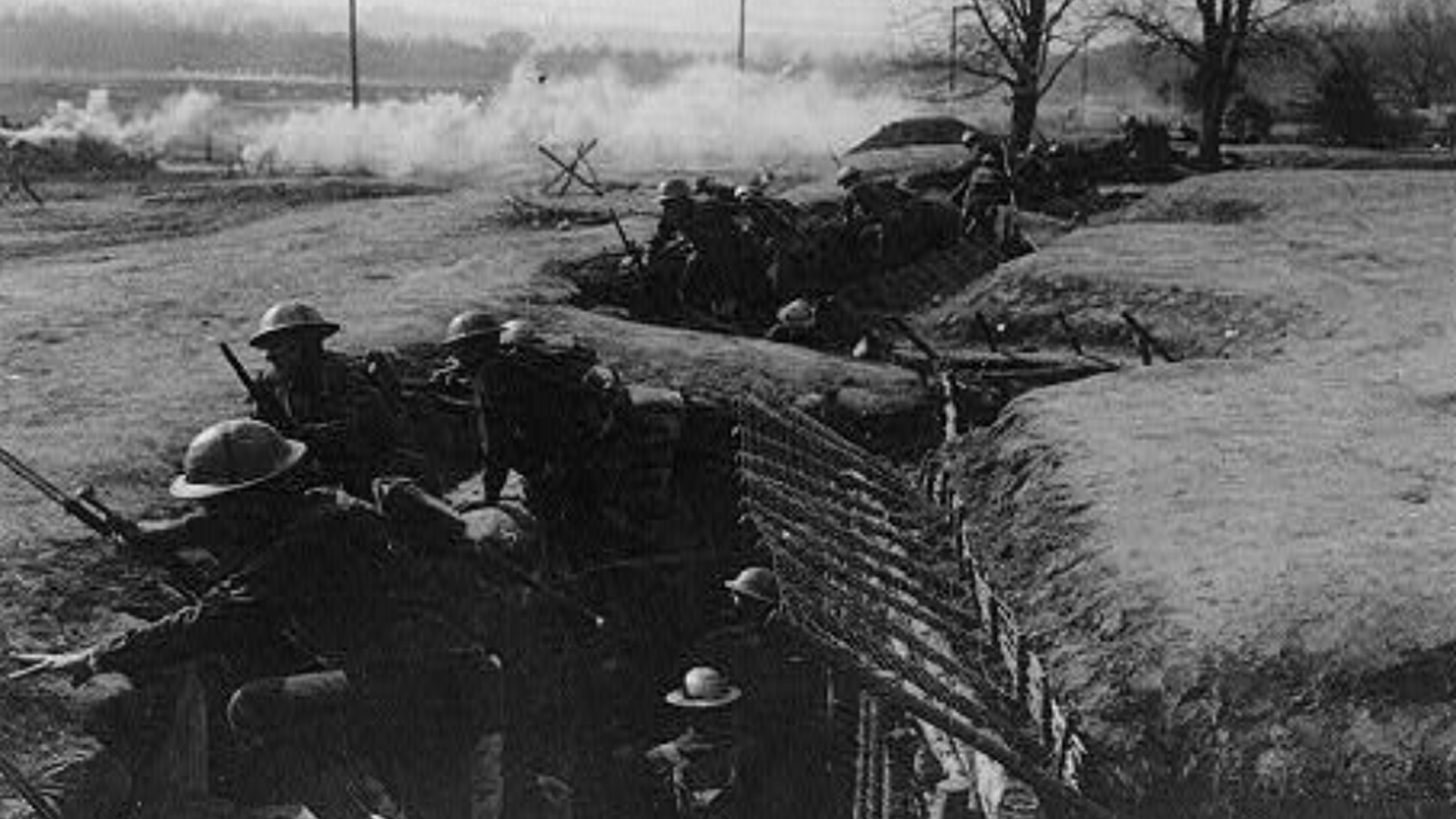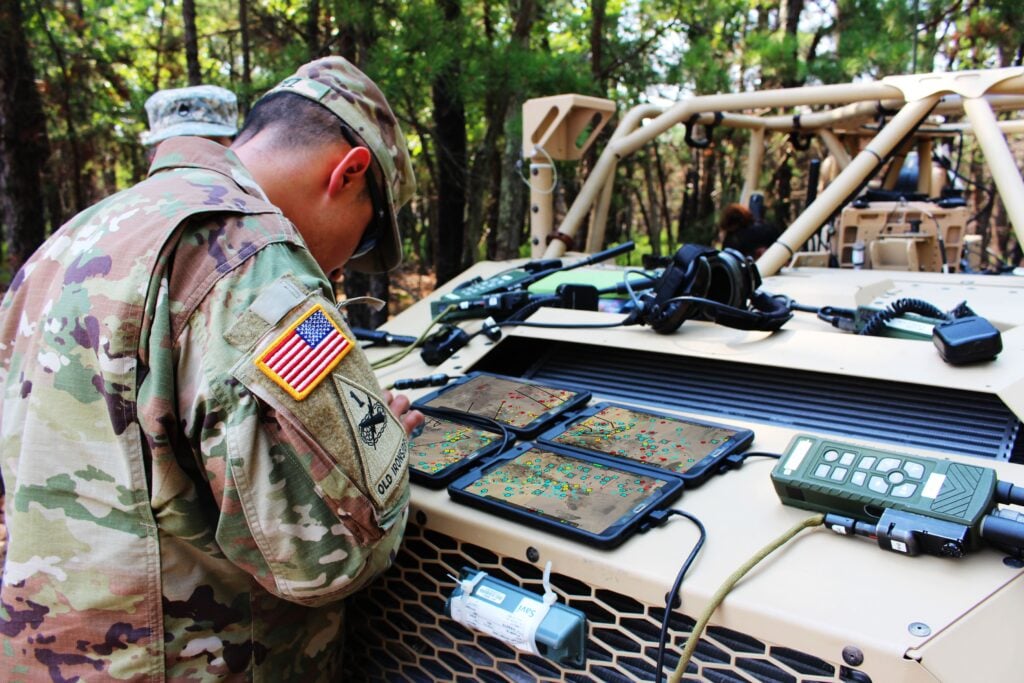SYDNEY J. FREEDBERG JR.

AUSA 2022 — In an age of drones, commercial satellite imagery and informants wielding smartphones, you have to assume the enemy is always watching, even thousands of miles from the front line.
That surveillance can pinpoint targets for long-range precision weapons, which means rear-echelon command posts, support troops and supply dumps are under threat of attack like never before, a threat that changes how they have to operate. But how do units spread out, take cover, and keep moving — to avoid being spotted, targeted, and struck — while still coordinating any kind of effective action?
That’s the tactical dilemma the Army attempts to tackle with its new multi-domain operations doctrine – and the critical technical challenge for its still-in-development battle network.
“We must account for being under constant enemy observation,” said Lt. Gen. Milford Beagle, chief of the Fort Leavenworth Combined Arms Center, which put together the all-new edition of Field Manual FM 3-0, Operations. “The battlefield is transparent, and so we have to be dispersed, we have to be more agile.”
“Dispersion is critical,” Beagle told the annual Association of the United States Army conference, during a panel on the future Army of 2030. “[But] then how do we go from dispersed locations to bring those forces back together to achieve decisive effects?”
“[Especially] if you’re in a theater like INDOPACOM,” he said, “you’re going to be largely non-contiguous” – with different subunits potentially scattered over multiple small islands, rather than forming a contiguous battle line – “but still, at some point, you’re going to have to converge all those capabilities, concentrate all those capabilities, on multiple decisive points.”
Thrashing out the tactical and technical complexities is the purpose of the Army-led, multi-service Project Convergence wargames, which this fall include British and Australian troops in both European- and Pacific-inspired scenarios.
“It’s not just the Army,’” said Lt. Gen. Richard Ross Coffman, the deputy chief of Army Futures Command. “This is our joint force, our Five Eyes partners that are there with us…. We will always fight together, and we’ve got to get our communications, our long-range fires [coordinated].”
“We want to better understand how coalition and joint forces can fight together… so we can either create a new technological solution or use an existing solution,” Coffman told a separate AUSA event. “How [do] we map out both message traffic sent from sensors and received by shooters across the joint force?”
Dealing With Dispersion
“Everything is very simple in war,” Carl von Clausewitz wrote, “but the simplest thing is difficult.” In the two centuries since his time, a new factor has added to the difficulty of the simplest things in war: the imperative to disperse in the face of withering firepower. And as weapons have become more lethal, dispersion has become necessary, not just for frontline fighters, but throughout continent-sized theaters of war.
In the Napoleonic Wars of the early 19th century, Clausewitz fought on battlefields where men stood shoulder-to-shoulder under fire, accepting a greater risk of being hit in order to concentrate their own firepower. In the era of inaccurate, slow-loading muskets, which fired three times a minute and could barely hit a barn beyond a hundred yards, that was a reasonable trade-off. Against the rifled muskets of Solferino and the US Civil War just four decades later, it was a riskier and bloodier approach. Against the machine guns and massed artillery of the First World War, it was suicide.

American soldiers leaving a trench during World War I. (Keystone View Co. via Library of Congress)
So, soldiers spread out, took cover and dug in. When it became clear that a long-enough bombardment could slaughter even troops in trenches, armies largely pulled back out of artillery range, leaving a screening force in the frontline trench while holding most of their men in reserve. In the offense, the German Stosstruppen – translated into English as “stormtroopers” – learned to advance while dispersed, moving forward in small groups to take advantage of every scrap of cover.
But dispersion did not stop there, because weapons — and the systems that found targets for them — became ever longer-ranged and more precise. In World War II, airstrikes ravaged supply columns, reinforcements and infrastructure far beyond the front. In Ukraine and Russia today, kamikaze drones and precision-guided rockets destroy ammo dumps, airfields and civilian infrastructure. In a future war between two high-tech powers – say, the US and China – immense arsenals of long-range precision weapons could strike targets hundreds or thousands of miles away. Space-based surveillance can detect, and cyber warfare can disrupt, operations anywhere in the world.
“Any force that has to fight in 2030 or beyond, we need to be prepared for a very active campaign against the homeland,” said Mario Diaz, deputy under secretary of the Army, speaking at AUSA alongside Beagle. “It can contribute to our inability to get what we need from our forts and our ports to the battlefields.”
The new operations manual warns, “Planners should anticipate adversary forces using all available means to contest the deployment of forces, beginning from home station. […] Leaders must assume they are under constant observation from one or more domains and continuously ensure they are not providing lucrative targets for the enemy to attack.”
“Forces that are concentrated and static are easy for enemy forces to detect and destroy,” the manual emphasizes. “One way Army forces preserve combat power is by maintaining dispersion to the greatest degree possible.” Long before they reach the front, it says, units arriving in theater must “disperse elements into company-sized tactical formations while they are performing maintenance checks, loading munitions, ensuring crew readiness, and preparing to move to forward positions.”
But spreading out makes it harder to work together. “Although dispersion disrupts enemy targeting efforts, it increases the difficulty of both C2 [command & control] and sustainment for friendly forces,” FM 3-0 acknowledges. “Leaders [must] balance the survivability benefits of dispersion with the negative impacts dispersion has on mission effectiveness.”

An Army soldier tries out a prototype network device during a 2018 test. (Army photo)
The Network Must Work
This balancing act — the ability to coordinate action despite physical separation — depends on communications. But in the face of sophisticated adversaries, communicating isn’t as simple as grabbing a radio, logging into email or picking up a smartphone. Russia routinely jams GPS and communications satellites. Russian troops using cellphones in Ukraine given away their position to Ukrainian artillery, contributing to the deaths of a dozen generals. And even if an adversary can’t decrypt a coded radio transmission, they can triangulate its origin to locate the transmitting unit for attack.
“Continuous communication allows enemy forces to detect and target commanders, subordinates, and command posts,” FM 3-0 warns. “It should be avoided whenever possible.”
So, the military’s next-generation network not only has to transmit masses of data swiftly and securely: It also has to send it in short bursts, without prolonged transmissions that an enemy can trace. That is a tremendous technical challenge the Army will have to solve before it can execute its bold new tactics.
In that context, of the Army’s 35 top-priority modernization programs, from hypersonic missiles to augmented-reality goggles, Army officials said one was particularly key:
“I’d mention one and that’s the network,” said Doug Bush, the Army’s civilian chief of acquisition, speaking alongside Coffman at AUSA. “Not everything is dependent on our new network technology, but a lot of it is, and that’s a lot of the work that we’re doing at Project Convergence — to figure out how to do that network.”
“All of those things require people to communicate in a situation when an enemy is trying to take the network down,” he added, “so this is graduate-level networking.”
Coffman agreed. So did his boss, the four-star chief of Army Future Command, Gen. James Rainey.
“I don’t think there’s a single thing, but the network would be close,” said Rainey, speaking alongside Lt. Gen. Beagle at AUSA. “We believe everything you do is driven by the intel, [so] we’ve got to have a joint network, at speed and scale, that’s compatible with our partners across the joint force.
“It kind of makes it really hard to do any of the other things we visualize if we don’t bring that to bear,” he said.
The Army’s greatest asset here? Not tech, but people. “One of the advantages we have is actually our experience over the last 20 years,” said James Greer, a retired Army colonel and former director of the School of Advanced Military Studies.
“Our leaders, both non-commissioned and commissioned, have grown up on dispersed battlespace [in Afghanistan and Iraq],” Greer told the AUSA panel. “They have, through their experience, the ability to command and control when they are in fact separated, and they have the ability to bring in joint capabilities in support.” The challenge, he said, is “to scale that up.”
In the meantime, the Army, as usual, has a backup plan.
“But even… if nobody can talk, in the American Army at least, we’re not going to quit,” Rainey said. “Somebody will walk until they make contact and close with and destroy the enemy.”
No comments:
Post a Comment